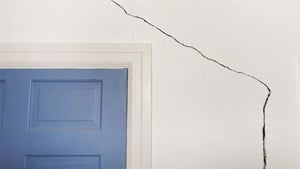When is a crack in a wall serious?
5 minute read

Sometimes, it can feel like the list of home improvements, DIY jobs and general sprucing up tasks that need to be completed in your home is only getting longer. Things break over time or from overuse and certain objects or appliances may need upgrading or replacing. But when you spy a crack in a wall or ceiling, you may feel concerned.

Over 50s Home Insurance
Age Co helps you protect the things you love. We’re 100% owned by Age UK and our profits go back to the charity.
Luckily, most cracks are completely normal in all sorts of houses, even new builds, and are simply a sign that the house is settling. Other causes of cracks include change in temperature or humidity levels and vibrations from traffic if you live near a busy or fast road.
Some cracks can be longer and deeper than others, but when should a crack start to worry you? Read on to find out.
When should you worry about cracks in walls?
Smaller cracks are generally nothing to worry about, however wider cracks, ones that run over doorways or those that run diagonally instead of vertically may be signs that something more serious is happening.
The cracks are wide
Hairline cracks of less than one millimetre in width or slight cracks of between one and five millimetres are generally not a cause for concern. If you begin to notice these, they can generally be filled and painted over as they’re a crack in the plaster but not in the wall itself.
A crack is more serious when it’s between five and 15 millimeters wide (0.5 to 1.5 centimeters, or up to half an inch) as the cause could be more serious than simply dried out plaster or a house that is settling. A damaged wall would be considered severe when it’s 25 millimeters or wider (2.5 centimeters or one inch) as it could be a sign of structural damage, subsidence (the sudden sinking of a house and its foundations) or something else. A crack this big could result in the building needing serious work, such as underpinning, to ensure it is stable.
The cracks run diagonally
If your home has walls that are plastered, then straight vertical cracks typically form when the plaster expands in humidity and shrinks as it dries. These are normal and are usually the type of cracks you’ll find in a new build property. Instead of fixing them straight away (as more will likely appear) you should wait a while before filling the cracks and repainting.
Jagged cracks that move in a diagonal direction or look like a set of stairs moving up your wall could be a sign of structural movement and may be slightly more serious than cracks that simply run up and down. You should look at how long and deep the crack is, and call out a structural engineer who might be able to advise you on the seriousness of the issue.
The cracks are located above door frames
Cracks will generally appear in the weakest areas of the wall, such as around a window frame. This is usually because a window compromises the strength of the wall slightly, causing cracks to appear. These aren’t usually anything to worry about, however a crack at the top of a door frame, or one that extends diagonally from the corner of a door is slightly more serious. These could be another sign of foundation damage or shifting foundations.
You can see daylight through the cracks
A crack that allows daylight to come into your home could be a concern. This is because it means the whole wall has shifted and not just on one side. Usually, a crack will appear on an external wall but cannot be seen inside, and vice versa. However, one large crack that appears to go through the whole house can be a sign of subsidence.
Does buildings insurance cover cracked walls?
Whether your home insurance covers cracked walls generally depends on the cause. For instance, your insurance may cover some damage caused by subsidence and ground heave. However, you could be required to pay an excess fee, and this could be higher than a standard fee. Cracks caused by your home naturally settling will not be covered. If in doubt, you should contact your insurance provider.
How to repair cracks in walls
If the cracks you’re trying to repair are quite large and deep, or wider than five millimetres, you may need to contact a structural engineer who can determine the cause and how it can be fixed. However, small hairline cracks in a plastered wall can be repaired relatively easily. Speak to a professional for advice.
Summary
Cracks can be concerning, but they are quite common. If you spot one, consider these key points:
- Cracks can be caused by changes in temperature, humidity levels, and even vibrations from nearby roads.
- Thin cracks are usually not cause for concern, but you should consult a professional if they become wider than five millimetres.
- Diagonal cracks that look like staircase steps can be a sign of structural damage, and you should consult a structural engineer.
- Likewise, cracks at the top of a doorframe can signal foundation damage.
- Another sign of a crack being serious is if sunlight can come through it – if this happens, you may be at risk of subsidence.

Sign up to the Age Co Newsletter
Each month, our email newsletter delivers inspiring stories, practical guides to later life, plus the latest news about Age Co and the charitable work we support.
